CW92 August, 2024
Strong quakes have jolted Chigasaki and western Kanagawa
A powerful earthquake hit the southern area of Miyazaki prefecture in Kyushu on August 8 (Thu) at around 16:40. The epicenter was in the Sea of Hyuga, about 30 km east-southeast of Miyazaki city, and the seismic center was 30 km below the sea level. The earthquake registered lower six on the Japanese scale in the coastal city of Nichinan, Miyazaki.
The Meteorological Agency soon issued the Nankai Trough earthquake extra information for 707 municipalities dotted from Okinawa to Ibaraki prefectures, saying people in these areas should be careful of a giant earthquake for the next week. In Kanagawa, 27 cities and towns, including Chigasaki, Samukawa and neighboring cities, were in the warning area. See green areas in the map below. (Warning map by the Meteorological Agency)
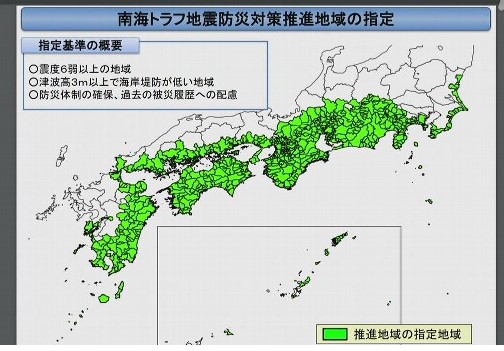
Another strong earthquake hit western Kanagawa again the next night (Fri) at around 20:00. It registered a seismic intensity of four in the Shonan area. The epicenter was the western part of the prefecture, and the seismic center was 13km below ground. Commenting on the earthquake, a university professor said, “As the epicenter is remote from the Nankai Trough, this quake does not relate to the trough.” However, as people rushed to supermarkets for food and water, shelves for these items became empty, and it took more than a week until bags of rice appeared again on the shelves.
On the evenings of August 14 (Wed) and the 15th (Thu), there were earthquakes again with a seismic intensity of one in and around Chigasaki. These three quakes gave a warning to us to remember earthquakes can occur at any time. Do you have foods, water, medicines, a flashlight, a portable radio, portable toilets and other emergency goods ready?
Thanks for their strenuous efforts at the Paris 2024 Olympics

Japan was awarded 45 medals, including 20 gold medals, at the Paris Olympics (Jul. 26-Aug. 11). Of 409 delegates, four were associated with Chigasaki and Samukawa. They were Shino Matsuda for surfing, Mina Sato for keirin, Sae Hatakeyama for bicycle motocross, and Sora Shirai for street skateboarding.
Sora Shirai was fourth in the men’s street skateboarding with a score of 278.12. Yuto Horigome won the gold medal with 281.14. Shino Matsuda lost her third-round heat to a Spanish rival, finishing the women’s surfing competition in nineth place. She was not blessed with good waves. Sae Hatakeyama failed to advance to the women’s BMX racing final. Mina Sato advanced to the quarterfinal in the women’s keirin and to the third round for the women’s sprint.

Unfortunately, they did not win medals, but they are still at the world’s top level of each event, and are role models for countless young athletes in Japan. May they start practicing for next big competition after refreshing.
Flowers of the Season: Patrinia Scabiosifolia
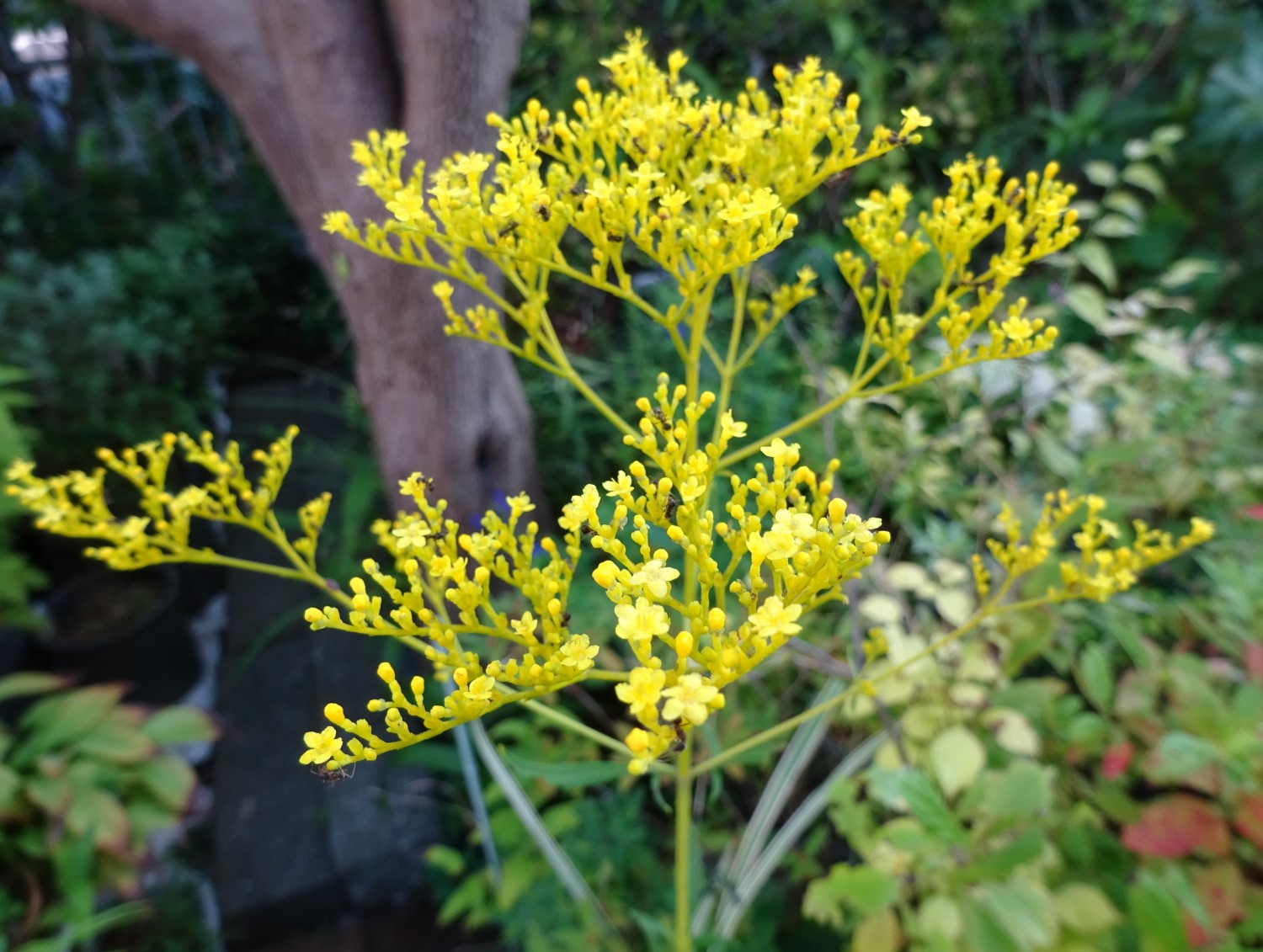
Patrinia Scabiosifolia has been loved by Japanese people since ancient times. The grass is among autumnal seven flowers*. The plant is often seen in sunny gardens and grassland. The Japanese name is ‘Ominaeshi’ (女郎花), which means its flowers are so beautiful that even beautiful women were overwhelmed. The name appeared in the anthology of waka poems by Michizane Sugawara and the long novel “Tale of Genji” by Lady Murasaki Shikibu, the two of which were completed in the 10th century.
The perennial herb grows from 60 to 100 centimeters high. From August to October, many short branches spread out from the end of its stalk, and each branch produces a large number of small yellow flowers. The size of each flower is from three to four millimeters in diameter, and each cluster of the flowers grows up to 20 centimeters. The opposite pair of leaves are long, narrow and thin, and jagged like the teeth of a saw.
Patrinia Scabiosifolia bears small dry fruits with the seeds distinct from the fruit walls, like strawberries. The plant reproduces from seeds, but in many cases, from sprouts.
The herbaceous perennial grows naturally in the whole of Japan except Okinawa, and from China to East Siberia. However, the flowers in the wild are spotted less frequently than before in Japan these days. The dried roots are used as a crude drug in Chinese Herbal medicine. It is said to have anti-inflammatory and diuretic effects. By the way, its congener blooming white flowers is called ‘Otokoeshi’ (男郎花) in Japanese.
*The autumnal seven flowers … Bush clover, Balloon flower, Japanese pampas grass, Dianthus superbus, Arrow root, Boneset, and Patrinia Scabiosifolia
History in Chigasaki: Shimoterao Village (2)
The wooden statue of Prince Shotoku is still in Jyoshoji Temple. But there are no historical records that explain why the statue is in the temple. From the site of Shichidogaran, ancient textured tiles and earthenware have been excavated, and the remains of the temple buildings have been confirmed. Many of the tiles were made in the Heian period (794-1185), and some date back to the Nara period (710-784). The city’s board of education has been excavating the ruins of the temple.
In the Edo period (1603-1867), the lords of the village were three vassals of the shogun: the Matsudaira, Nagai, and Kakei families. The Matsudaira family received 300石 (koku)* from Ieyasu Tokugawa in 1591 when the head of the family was Tadamasa. The Nagai and Kakei families each received their fiefs in 1596 and 1615 when their family heads were Akimoto Nagai, and Tameharu Kakei. The three were all brave soldiers of many battles.
*石 (koku): 石is a unit of volume. One koku was equivalent to the amount of rice an adult eats during a year. In 1669, one koku was decided to 175 liters and was corrected to 180.4 liters based on the metric system in 1886.
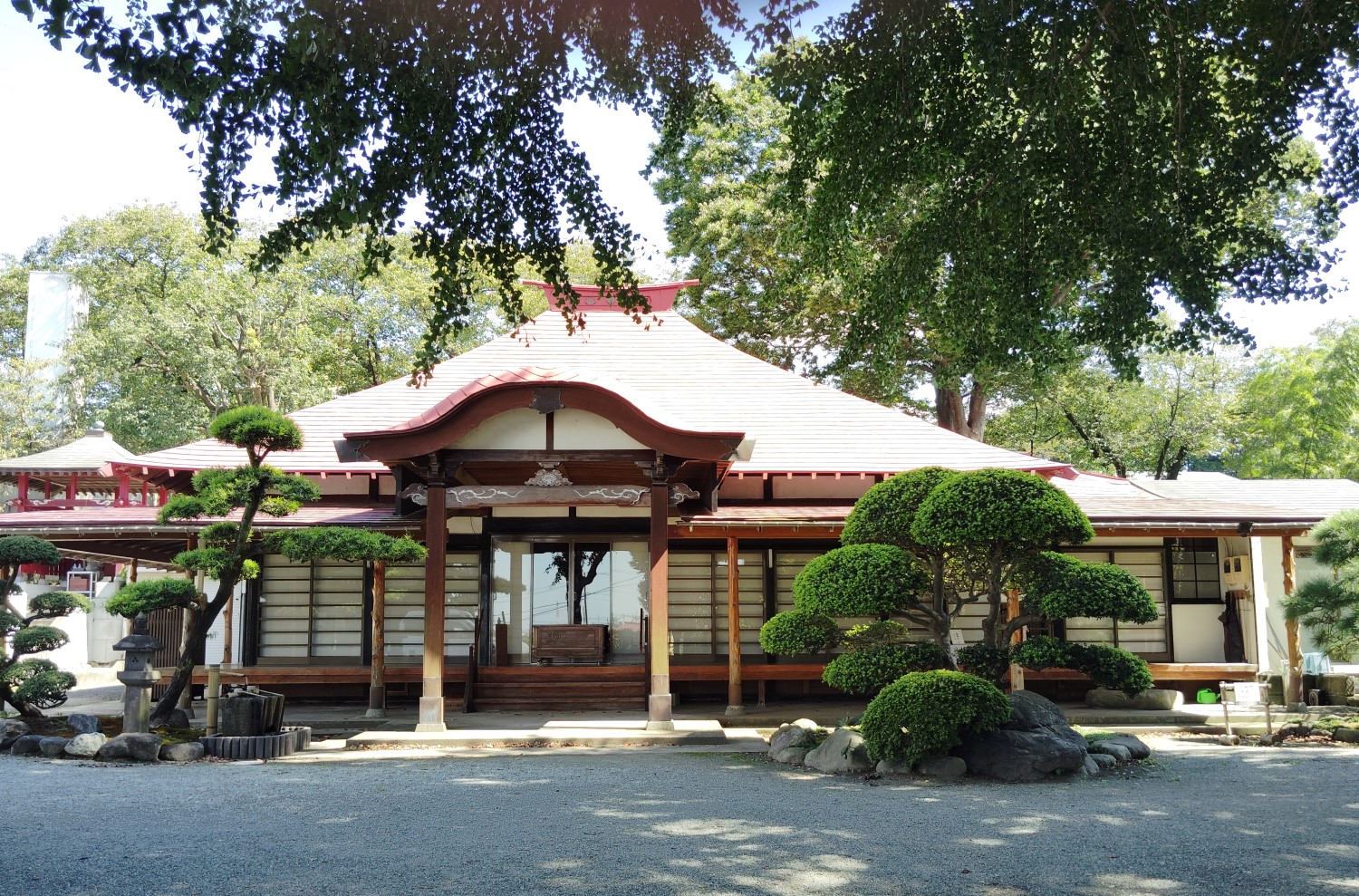
Hakuhoji Temple of the Soto sect was built by Shigetsugu, a grandson of Tadamasa Matsudaira, according to 新編相模国風土記稿 (the new edition of Sagami province topography). Shigetsugu was born in Shimoterao Village in 1607, and took the post of the town magistrate of Osaka in 1648, and died at 64 on June 3, 1671. He was buried in the precincts of Hakuhoji Temple. His posthumous name is 月照院白峰道晧, or Getsushyoin-hakuho-michiaki. The name of the temple was derived from the posthumous name.
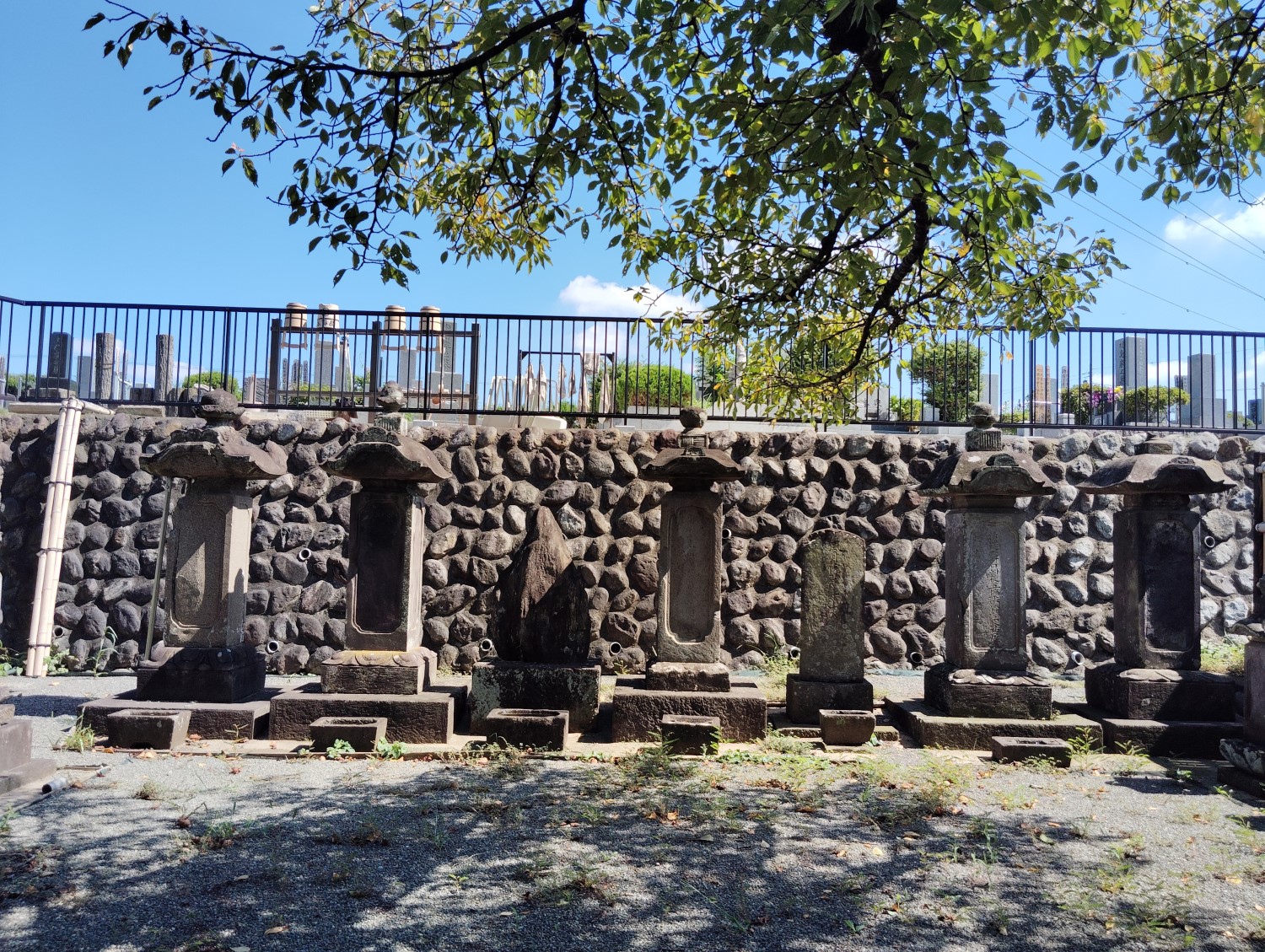
At the back of its main building, seven gravestones with stone hats on them stand in a line on a slightly elevated place. The fourth from the right is Shigetsugu’s stone. On the surface, his posthumous name is carved, and on the rear surface, the following words can be read: “寛文十一年??歳六月二日 南無十方佛 松平隼人正従五位下源重継”, or “Kanbun 11 (1671*) ?? years old June 2 Namujutsupoubutu Matsudaira Hayato Seiju Goige. *The writer added.
Interested in Japanese proverbs?
1) 酒は憂いを払う玉箒 (SAKE WA UREI WO HARAU TAMABOKI)
SAKE means alcoholic beverages made from rice, WA to be, UREI sorrow, WO a postposition for an object, HARAU to sweep, and TAMABOKI a decorated broom used to sweep silkworm houses at a ceremony on a January day.
Sake is like a broom. Just as a broom sweeps dust, so sake gets rid of our worries. The proverb is to praise sake, but to take a delight in drinking, you should drink moderately.
According to the health ministry, the daily intake of pure alcohol should be less than 40g for men and 20g for women.
The saying is in 洞庭春色, or Dotei Shunshyoku, a poem by a Chinese poet 蘇軾, or Su Shi (1036~1101). There is an alcoholic beverage named 洞庭春色, which is made from oranges.
Its English equivalents are:
●Good wine makes a merry heart.
●Wine makes glad the heart of man.
●Wine is panacea of all ill.
2) 損して得取れ (SON SITE TOKU TORE)
SON SITE means to suffer a loss, TOKU profit, and TORE to get something.
If you think you can make a large profit in the future, you should give it a try, even if you may suffer a loss at first. Some people say TOKU in the original sentence was not 得 (profit), but 徳 (virtue). If you work hard without regard to profits, customers will recognize your sincerity, and your business will grow.
There was once an important politician who always yielded achievements to others. Naturally, they deeply appreciated his consideration and eventually came to accept whatever he requested.
The saying is in 尾張俗諺, or Owari zokugen, a collection of proverbs used by ordinary people in today’s western Aich prefecture, completed in the late Edo period (~ the 1830s).
Its English equivalents are:
●Make the best of a bad bargain.
●One lost, two found.
●Gain can come at a loss.
Short Essays on Chigasaki (14) A poet, Doppo Kunikida & Nanko-in
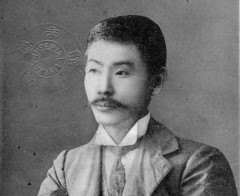
Doppo Kunikida, a Japanese poet, was admitted to Nanko-in, a sanatorium which used to stand in Nango, Chigasaki, on February 4, 1908, and passed away there on June 23, 1908 at the age of 37. Writers whom he had associated with in a literary circle, including Katai Tayama, Hakucho Masamune, often visited the sanatorium to see him. ‘Nijyu-hachi-nin-shu’ (二十八人集), a collection of works by 28 writers was presented to him in April, 1908, in hopes of allocating a supplement to his treatment costs. Doppo was so happy to receive it that he sometimes showed it to young writers who visited the sanatorium. (His portraite: from National Diet Library )
In May 1908, Seika Mayama started writing down at Doppo’s dictation with Katai’s support. After Doppo’s death, the dictation was published as ‘Byosho-roku’ (病床録), a deathbed record, in July 1908. Doppo says in the dictation, “I want to enjoy fishing at Yanagishima.” and “Scenery of Chigasaki is deserted, and nothing comforts my eyes except pine trees, barley, mulberry trees and sugar canes.”
Also, Seika serialized reports on Doppo’s medical condition in a newspaper, which resulted in spreading his condition, the name of Nanko-in and Chigasaki nationwide.
The source of the essay: Chigasaki People’s Book published by Chigasaki City
Short Essays on Chigasaki (15) Showa Emperor and the second house of Hisamoto Hijikata The modern times】
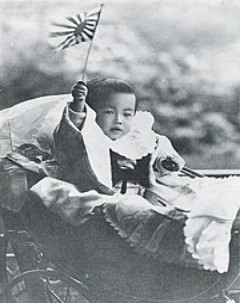
Measles broke out in Oiso on March 12, 1902. At that time, Prince Hirohito (later Emperor Showa) was staying at the second house of Marquess Naohiro Nabeshima (the former Saga feudal lord and an imperial advisor) in Oiso. So, he was immediately moved to the second house of Hisamoto Hijikata (the former minister of the Imperial Household) in Chigasaki on March 13.
(Photo on the left: Prince Hirohito in 1902 from Wikipedia
Accompanied by Marquess Sumiyoshi Kawamura (the former Satsuma feudal lord, a prince guardian), he left Oiso Station at 4:45pm and arrived at Chigasaki Station at 5:05pm on March 13. The Crown Princess (later Empress Taisho) was so worried about him, and sent staff members serving at the Crown Prince Palace to Chigasaki. The Hijikata’s second house stood near the Chigasaki Elementary School. An old man saw the prince accompanied by ladies in the imperial court playing at the school yard from a distance.
The prince accompanied by the couple of Kawamura and chamberlains left the Hijikata’s second house at 12:45pm, heading to Chigasaki Station and safely arrived at the Kawamura’s house in Azabu, Tokyo. He was welcomed by the imperial advisors at the Shimbashi Station.
The source of the essay: Chigasaki People’s Book published by Chigasaki City
Events in August
Muse In Art Nouveau by Alfons Mucha at Chigasaki City Museum of Art
Nearly 210 works by Alfons Mucha were exhibited from June 18 (Tue) to August 25 (Sun). They were posters, illustrations, calendars, panels, post cards, and postage stamps as well as pictures printed on convenience goods. Mucha was born in Czech in 1860, and moved to Paris at 27 in 1887. He learned painting at art schools in Munich and Paris. Listless- or depressed-looking ladies in dull colors fall into thought. Several ladies give sharp glares to something. They are all elegant and cute, and do not have an earthly feel at all. He is called a standard-bearer of Art Nouveau.
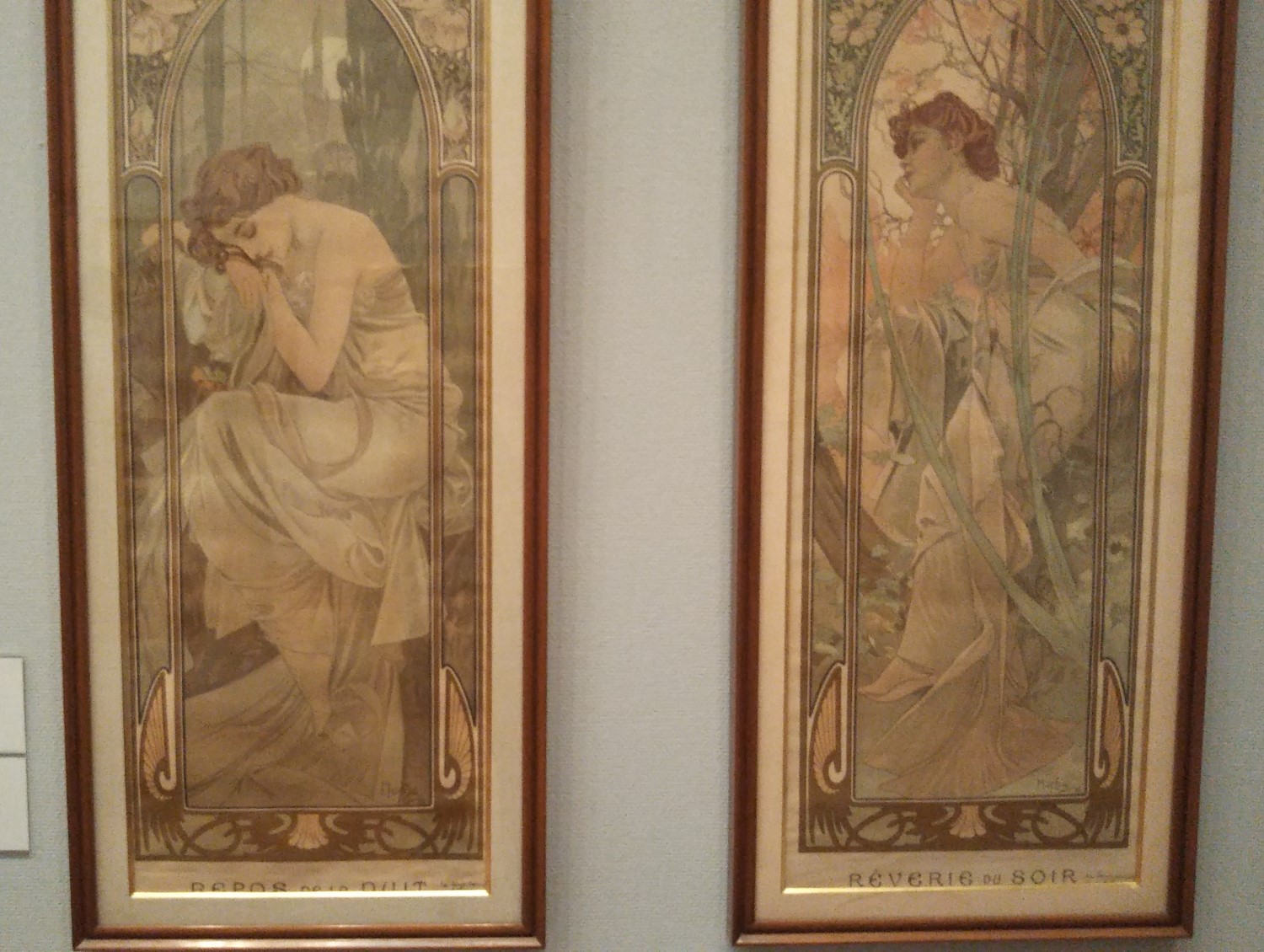
In 1910, he returned to his home country Czech, and started working on drawing the Slav Epic, one of his masterpieces.
In the spring of 1939, he was arrested by the German Army. They said his pictures aroused Czech people’s patriotism. He was soon released, but four months later, in July, he died of worsening condition at 78.
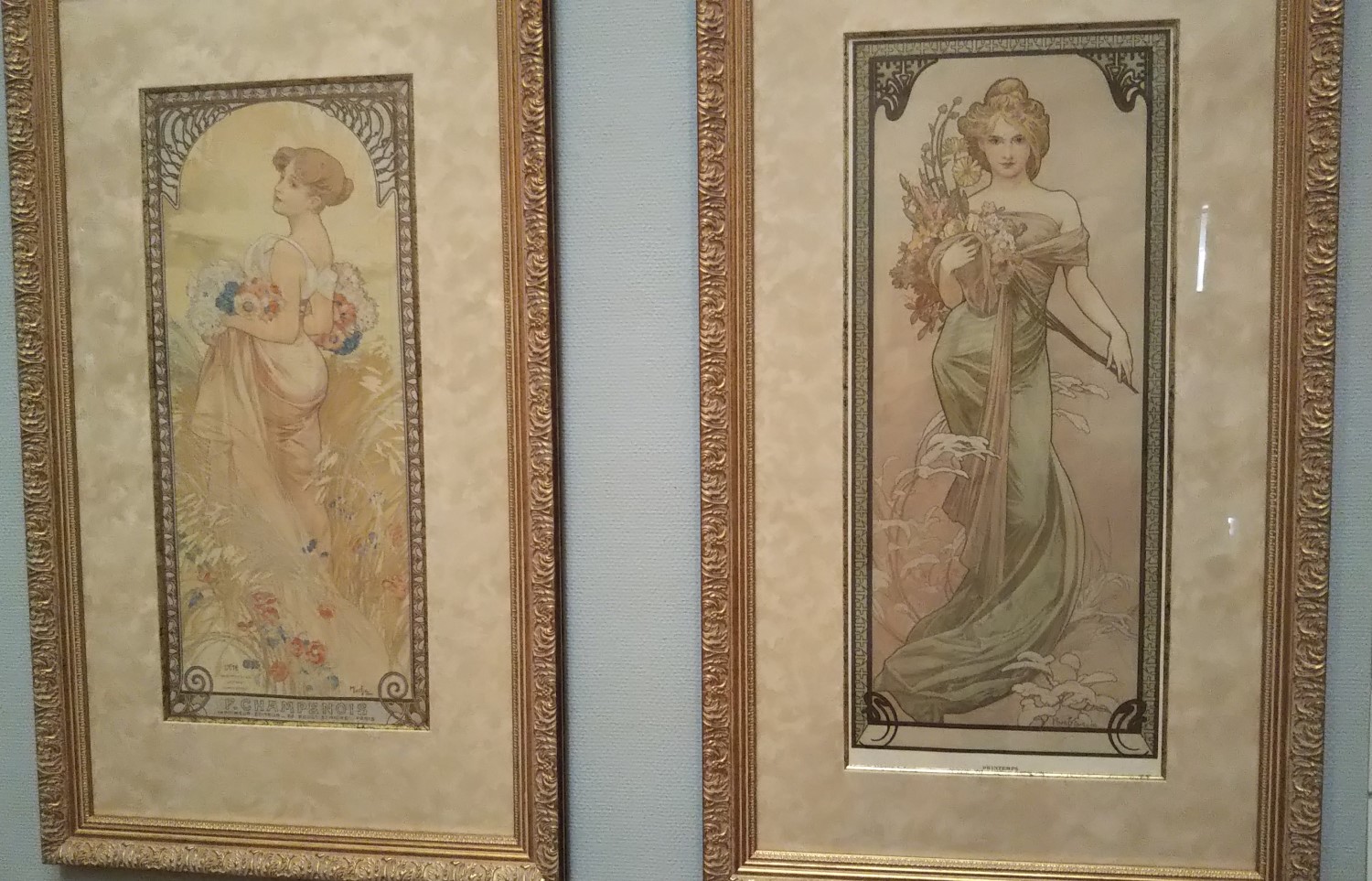
The IM internet museum has posted a video of the exhibition. Goto
https://www.youtube.com/watch?v=4CV8sDcBLe4
A lecture meeting entitled “Atomic Bombings and Haiku”
Annual memorial ceremonies for victims of atomic bombings and world peace were conducted on August 6 in Hiroshima and the 9th in Nagasaki, hoping such atrocities will never be repeated again. In addition, various gatherings have been held nationwide not to erode the memories of the war. Although 79 years have passed since the atomic bombings of the two cities in 1945, there still remains a perception gap regarding the bombings between Japan and the US.
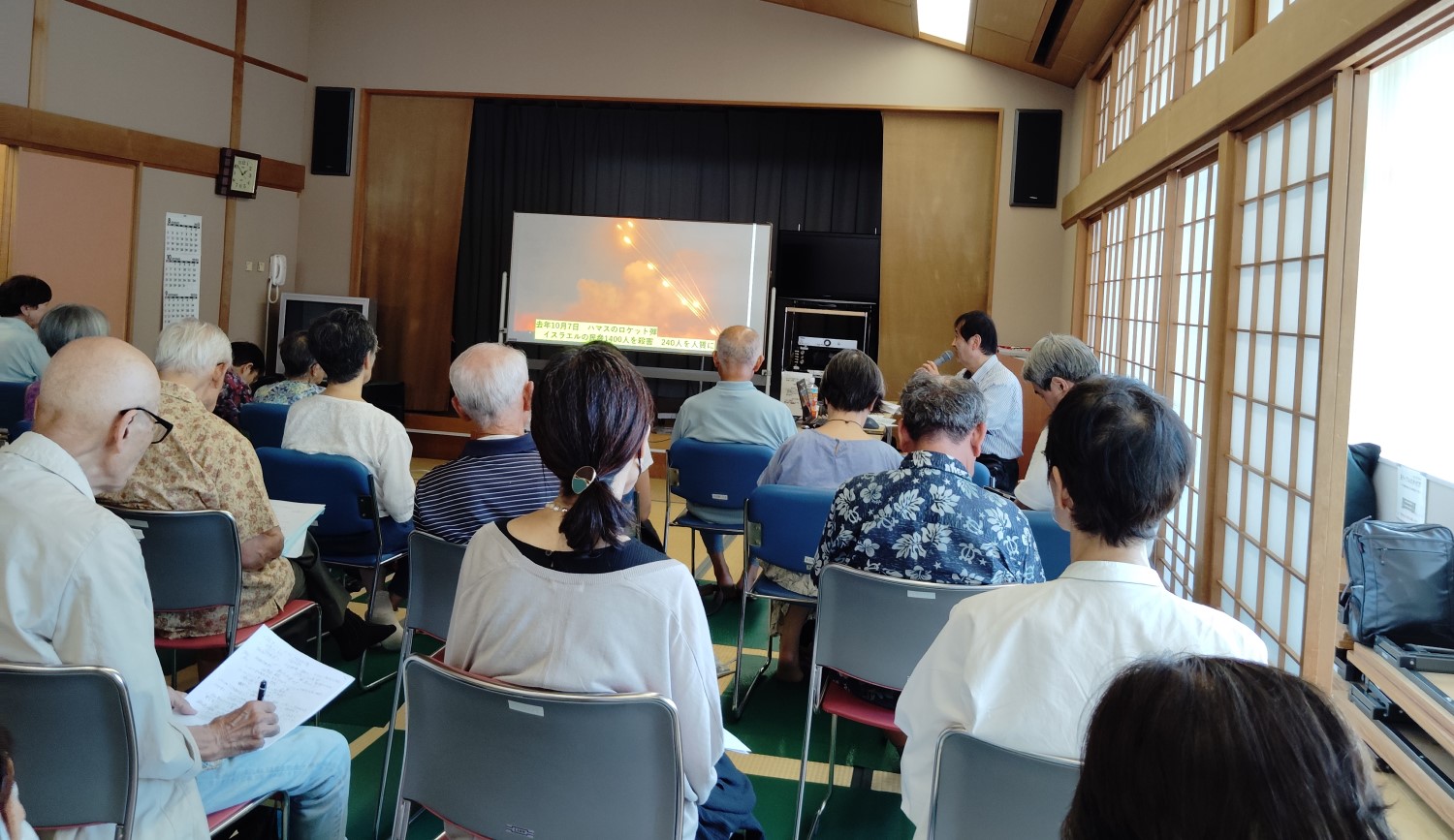
On August 17 (Sat), Ikoino-sato in Hagisono, Chigasaki, invited a former NHK director, and now a professor at Musashi University, Kozo Nagata, as the speaker on “A bombings and haiku.” He said his mother was a survivor of A bombing of Hiroshima. When the bomb exploded, she was about 800 meters from the ground zero. He also said he was sorry that Prime Minister Fumio Kishida’s speech at the ceremony was the same as that of last year. He hoped Kishida would take a vital role in the abolition of nuclear weapons, considering today’s world situation.
GHQ imposed strict censorship of the media and literary figures from September 1945 to October 1949 in order to conceal the tragedy of A bombings. They did their research not to save atomic bomb victims, but to confirm the power of the two bombs. Even after the censorship was lifted, the Japanese media was reluctant to report the real damage actively in the years that followed.
Nevertheless, many Japanese writers, painters, photographers, and poets had made efforts to report the miserable conditions of Hiroshima and Nagasaki since the end of the war. They kept saying or writing instead of media journalists. For example, a poet group in Hiroshima issued their first bulletin featuring the atomic bomb in March 1946, and their activities continued until the publication of its 18th issue in July 1948. After the US occupation ended in 1952, haiku poets composed many haiku publicly. They were terribly shocked by pictures and photos depicting atomic bomb victims.
In March 1954, 23 crew members of tuna fishing boat Daigo Fukuryu Maru (No.5 Fukuryu Maru) were exposed to highly radioactive fallout caused by the US H-bomb test at Bikini Atoll in the Marshall Islands, and one of them died six months later. The incident triggered a movement for antinuclear haikus, as anyone can condense their feelings into the world’s shortest poem with 17 syllables.
Film screening - The trail of Akira Tsuru’s mind and heart
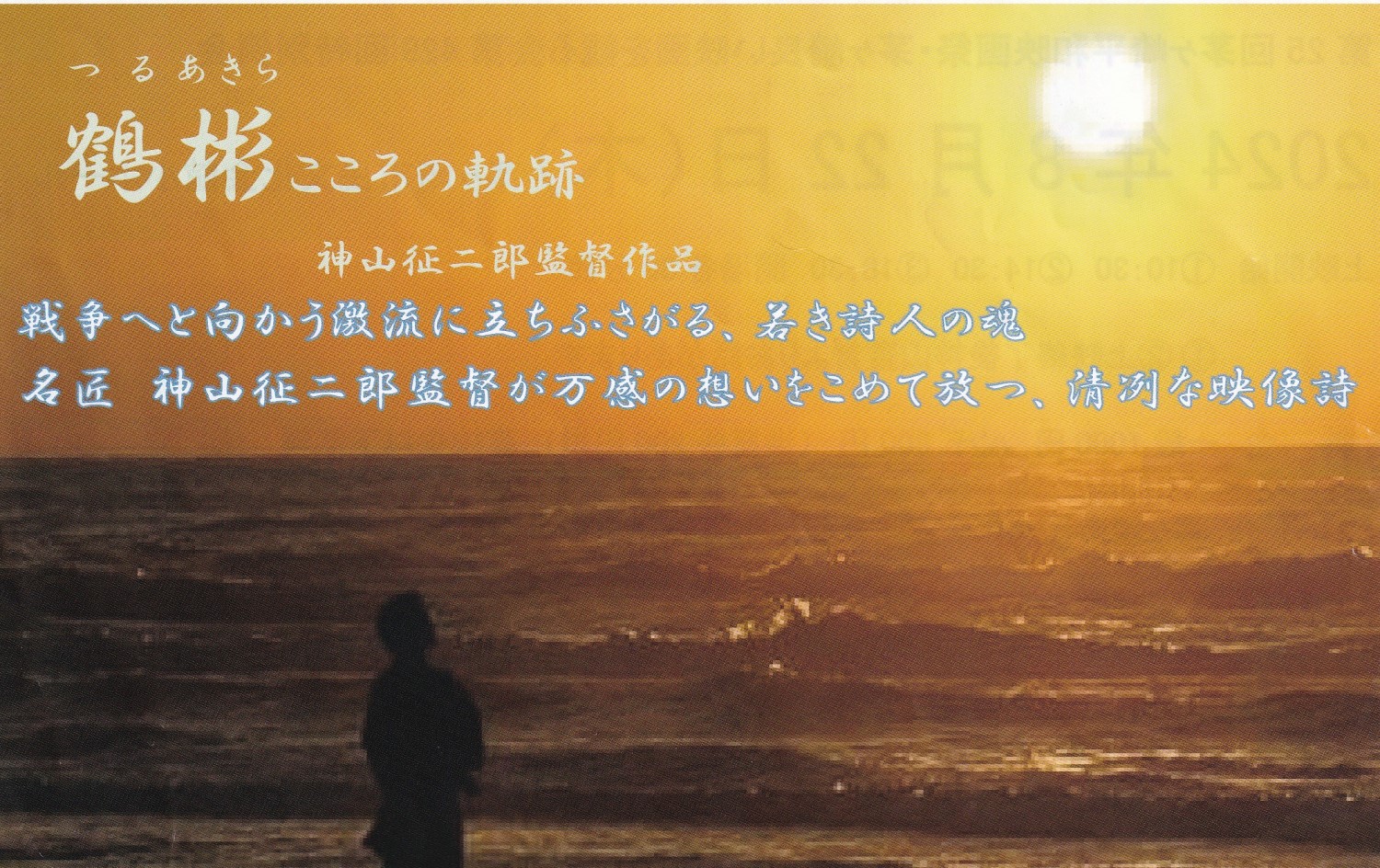
A film screening of “The trail of Akira Tsuru’s mind and heart” took place at the Civic Hall on August 22 (Thu). The 2009 film, directed by Seijiro Koyama, depicted the life of antiwar and anti-authority senryu poet Akira Tsuru, whose real name was Katsuji Kita.
Senryu: humorous verse in three lines of 17 - five, seven and five - syllables.
At 9, he lost his father. His mother soon remarried. At 17, he left his foster father’s house for Osaka, and then went to Tokyo a year later. He studied senryu under a couple in Tokyo who ran a senryu magazine. At 21 he returned to his home town to enlist in the army in Kanazawa. He was discharged from the army four years later at 24, and concentrated on composing senryu. At 28, however, he was arrested in violation of the Maintenance of the Public Order Law by the Special Political Police. Excruciating torture and dysentery killed him in the detention at 29 in 1938. His body had been bound with a rope to the bed.
Kita composed more than 1,000 senryu and wrote about 90 pieces of senryu criticism during his short life. While Japan was rushing to militarism, Kita persisted his antiwar attitude. His senryu was far more serious and urgent, compared to those we frequently see in newspapers. The scenery of rough waves of the Sea of Japan in winter expressed his fierce life. The following is one of his senryu.
手と足をもいで丸太にしてかえし (Te to ashi wo moide maruta ni site kaeshi)
Army recruited a man. Once he lost the limbs on a battle ground, they sent him home. (literally translated by the writer)
Events in September
Exhibitions at Citizen Gallery (Admission free)
●The 10th picture exhibition by Miyoshi-kai: Sept. 4 (Wed) 13:00~17:00, the 5th (Thu) to 7th (Sat) 10:00~17:00, the 8th (Sun) 10:00~16:00
●The 13th Shonan photo club exhibition: Sept. 13 (Fri) to the 15th (Sun) 10:00~18:00, the 16th (Mon) 10:00~17:00
●Tansai (wash drawing) Chigasaki sketch exhibition: Sept. 28 (Sat) 13:00~17:00, the 29th (Sun) to Oct. 2 (Wed) 10:00~17:00, the 3rd (Thu) 10:00~16:00
Pleasant voyage at the city museum of art
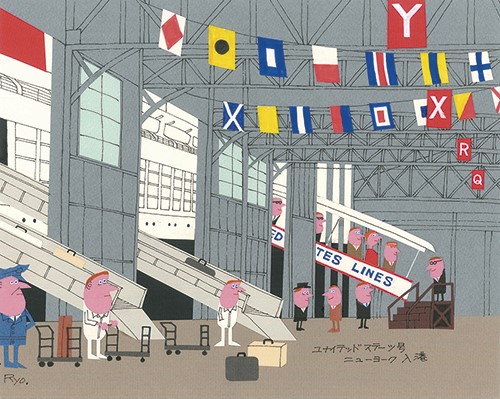
Pictures by Ryohei Yanagihara will be exhibited at the city museum of art from September 3 (Tue) to November 10 (Sun). Ryohei Yanagihara (1931-2015) worked at the advertising department of Suntory. The catch phrase of sales promotion campaign “Let’s Drink Torys and go to Hawaii,” grew Japanese people’s longing for Hawaii. He is known for having a knowledge of ships, and left many essays and pictures about voyages and ships.
The exhibition will be held in commemoration of the 10th anniversary of the sister city relationship between Chigasaki and Honolulu.
Entrance fee (yen): Adult 800, Uni. Student 600, Citizen aged 65 and older 400, High school student and younger as well as disabled person and their caretakers free.
The 17th Koide River Higanbana Festival
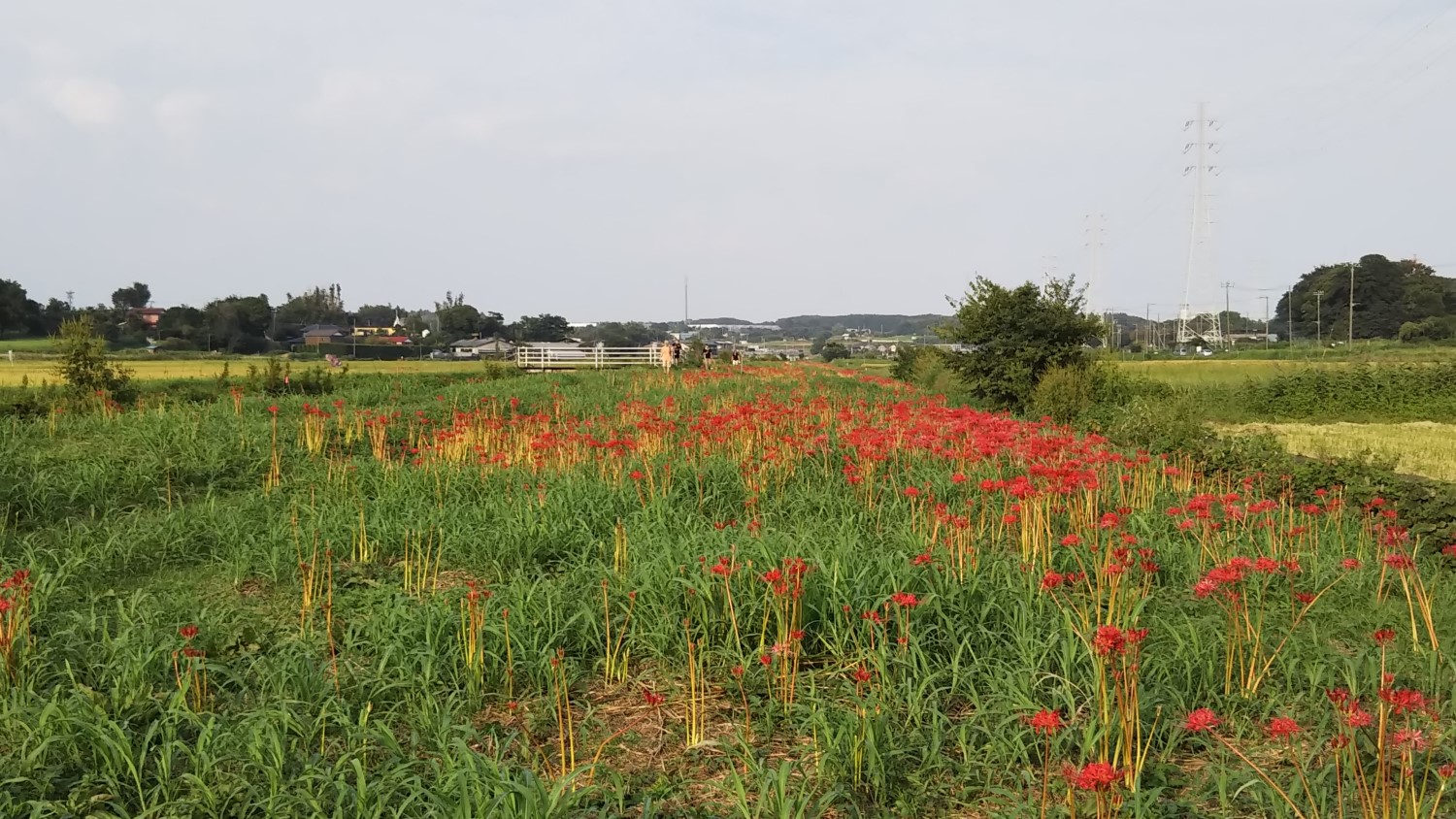
Red spider lilies will soon bloom along the bank of the Koide River, on the three-kilometer stretch from the Daikoku Bridge in Fujisawa to the Square for Young People in Samukawa. The best season is from early September to early October. On September 21 (Sat), a ceremony is going to take place in the square, Uchimodori and Endo in Fujisawa.
On a fine day, you can see Mt. Fuji, Tanzawa and Izu mountains. How about walking in northern Chigasaki and refreshing yourself?